Country Club of Fairfield
CT, USA
Green Keeper: David Koziol

One of the great environments for a game is found at the Country Club of Fairfield.
The game of golf in America is in dire straits. As opposed to a relatively inexpensive pursuit that is played in under three hours in the United Kingdom, the game in this country has devolved into an all day affair. Compounding the problem are the private clubs that grossly overspend and mismanage their courses, in turn sticking their members with ever escalating expenses.
There remain a few havens in America where golf as originally conceived in the United Kingdom is alive and well. Country Club of Fairfield is one such spot. Mercifully, in a state where most clubs don’t get it, here is one that understands that the purpose for its course is to provide enjoyment for its members. When faced with decisions regarding the course, a former green chairman would pose the question aloud, ‘What would the shepherds do?’ At the heart of thequestion is the concept of keeping things simple and natural and not to over embellish. This guiding principal has served Fairfield well to where it is now a standout for how a course should be managed.
Before the concept of restoration gained favor at other leading private clubs that possessed Golden Age designs, Fairfield’s membership developed a Master Plan in 1992 which signaled the need for restoration. This eventually led to Renaissance Golf Design and Bruce Hepner being hired in 1999. When first presented with Hepner’s plan, the club actually suggested shortening (a fabulous move that other clubs should consider) the golf course with the addition of two new, shorter tees at the fourteenth and seventeenth holes. While other clubs wrongly focus on stretching their Golden Age design by adding awkward back tees, Fairfield concentrates thought and resources on the white tees where 85% of member play occurs. Yet, as it stands today, Fairfield’s length of just over 6,400 yards remains plenty challenging for 99.99% of golfers, especially given its windy site and that its par is a tight 70. As testimony to this fact, the average score during the 2008 Metropolitan Open that Fairfield hosted was 74.83, nearly five shots (!) over par per round.
A game here embodies the finer virtues that have stood the game in good stead for over a century. First, this low profile Seth Raynor design doesn’t distract the golfer’s eye from the beautiful surrounds. Rather, the golfer is always pleasantly reminded of the seaside environment. Hopefully, a breeze will be up too, helping to promote further the time honored notion of golf as a battle of man versus nature. Second, the course is maintained in the only manner that is appropriate (though few clubs do it): the playing surfaces are keep fast and firm but as one strays into the rough and native areas, a wide variety of lies greet the golfer. Randomness is a key attribute in nature and Fairfield stands apart from the over watered, over maintained courses that promote uniform lies. In a dry summer, the course reflects that fact with baked fairways. In a wet summer (which happens to be when these photographs were taken), the fairways are greener and the holes stretch out a bit as the roll from a tee ball is reduced.Fairfield’s maintenance program as directed by Green Keeper David Koziol allows the course to resist any artificial or over-maintained appearance. Third, the short green to tee walks that are commonplace on all Golden Age designs allow the golfer to enjoy his round here in under three hours. The lengthening practices that have marred many a good walk elsewhere has never been pursued here (remember: what would the shepherds do?).
As spending four plus hours on a golf course continues to become out of reach for many busy people, one appreciates finding a club where they understand the role of golf within one’s life: The game can bring friends and family together but it shouldn’t take more than a few hours as there is plenty else to be done. Fairfield’s charm is found in how man is free to reconnect with nature and do battle, all within a reasonably short amount of time. Given its coastal ambience, it’s no wonder that Fairfield’s fan base is so broad.
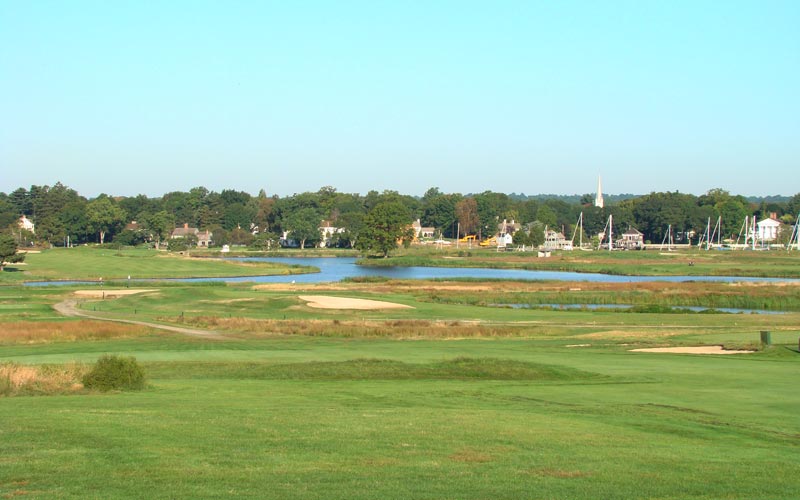
Where there are yacht masts, there’s wind. With few trees to block its effects, the golfer is guaranteed prime playing conditions akin to the links in the United Kingdom.
As seen in the four photographs below, the bunkering here is more diverse than found on most Raynor courses. Of course, one reason is that A.W. Tillinghast and Robert Trent Jones also had a hand in the evolution of the course but there is far more to the bunker story than just that. When the opportunity existed to go steep and deep (i.e. up on the hillside at the Redan), Raynor was quick to oblige. Below in the flats, that wasn’t an option but Raynor’s creativity made up for it. One thing Raynor didn’t do was to push up the green pads seven to nine feet (which thus lends itself to deep greenside bunkers) ala his work in the Low Country around Charleston, South Carolina. The green pads at Fairfield are lower profile in nature, rarely more than four feet in height, in part because fill was at a premium during construction as it was brought in from barge from Long Island or by dredging Southport Harbor. Indeed, this requirement made Raynor a particularly logical choice to become Fairfield’s architect given his recent involvement in 1917 with the massive (world class) land fill project at Lido.

An eight foot deep bunker guards the left inside of the Redan green with three foot deep bunkers (out of view in the photograph above) lining its high right side.
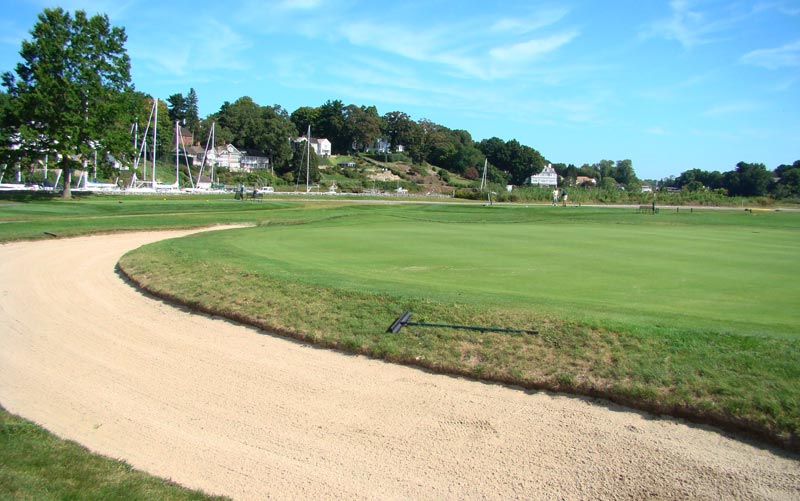
Steep and deep bunkers that characterize many of Raynor’s other best courses weren’t always an option at Fairfield as the water level is only a few feet below ground. Nonetheless, this classic ‘U’ shaped bunker that rings the back of the second green leaves little doubt that the golfer is playing a Golden Age course.

When the architect couldn’t go down, one of the best options was to build up the bunker walls and flashed-up the sand faces. Pictured above is the sixteenth green with such greenside bunkers.
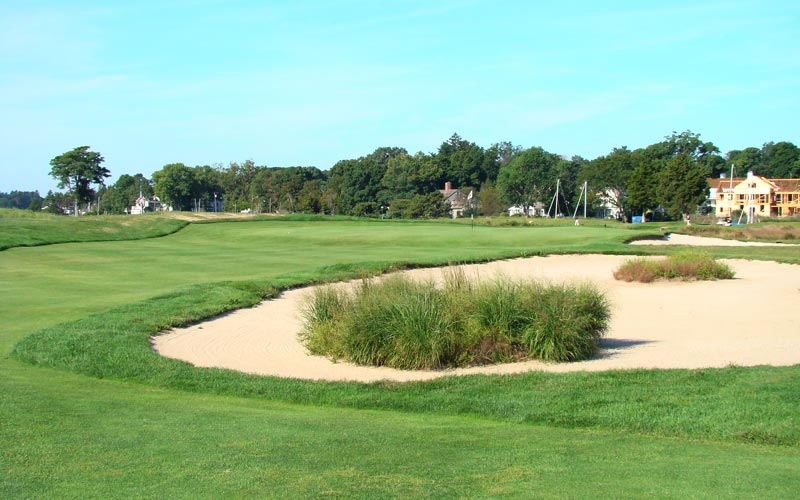
A 1934 aerial shows several bunkers had natural vegetation in them, which is unique for Raynor. Such vegetation helps bunkers that lack depth to function as true hazards that need to be avoided. Pictured above is the bunker at the thirteenth.
Holes to Note
Second hole, 405 yards, Long; The world’s shortest Long hole, with that story told in the first photograph below. One of the outstanding attributes of the course is its routing with the front nine running counter-clockwise around the perimeter of the property and the second nine running loosely in a clockwise direction within the loop created by the first nine. Such a routing only matters if the site is windy, which is the case at Fairfield. Like Kennemer in the Netherlands and Muirfield in Scotland, the holes play wildly different depending on the wind. In the case of Fairfield, the wind is generally off the sound which means it blows left to right across the second. When the wind is blowing off-shore, it is right to left here and the hole becomes easier, as tee balls tend to seek the left side of the fairway from where it is ideal to approach the green.

This is the view from Raynor’s original tee which was high on the hillside. From here, the hole was a three shotter of 505 yards and hence its name.
Third hole, 355 yards, Bottle; The fact that this hole exists as Raynor designed it speaks highly as to what a good steward Fairfield has been. For instance, at Yeamans Hall where they have done an outstanding job in all other respects, the one prominent design feature that they have been reluctant to restore is the central Bottle bunkers in the fourth fairway. Since the days of St. Andrews and Woking, central hazards have long been viewed in the United Kingdom as crucial to good golf course architecture. Sadly, this view is not equally shared in America. The state-side version shows a resistance to placing bunkers where they are most in the way and instead bunkers are often times found off to the sides of fairways. Master architects like Stuart Paton at Woking, C.B. Macdonald (and hence Raynor), Walter Travis, and Herbert Fowler all knew better: Placing bunkers in the middle of fairways is the surest way to create strategic dilemmas. In the case of the third, clear sailing is had by playing up the right side of the fairway. However, only those that play down the left and challenge the five fairway bunkers are afforded a good angle past the right greenside bunker.
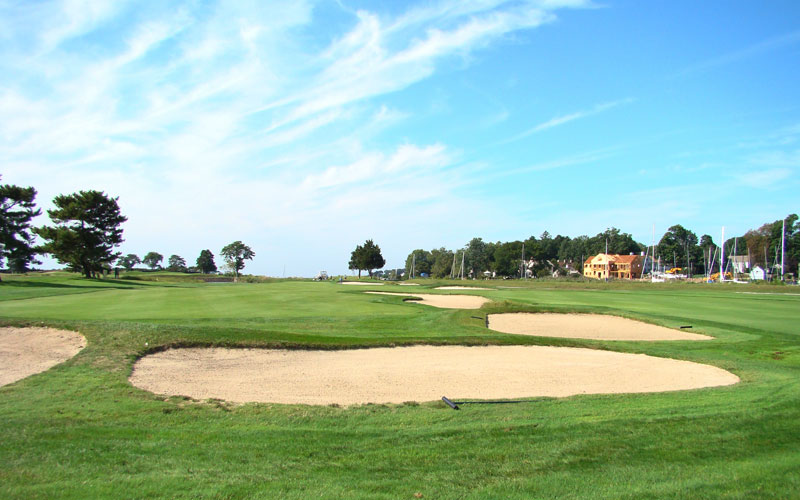
For over eighty years, these central bunkers have forced golfers to make decisions as to whether or not to play down the left or right side of the third.
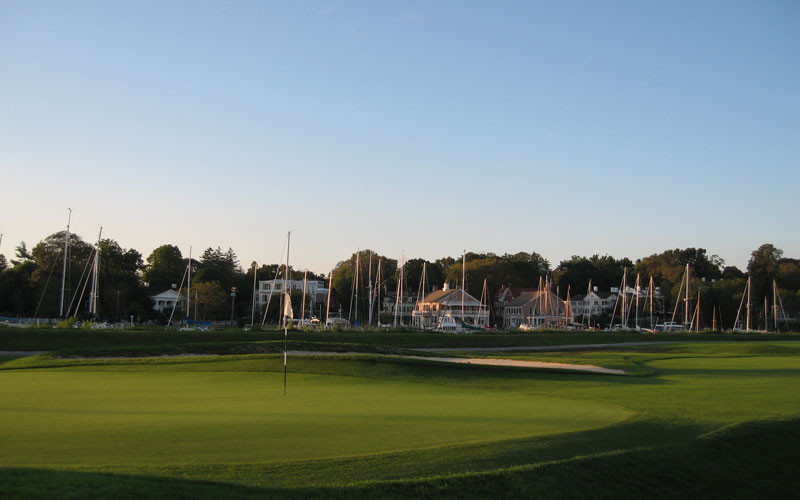
As seen from the back left of the green, one appreciates that the high bunker wall that feeds into the green makes front right hole locations tough to get near unless one’s approach angle is from the left portion of the fairway.
Fourth hole, 135 yards, Short; After Raynor’s death at the relatively young age of 47 in 1926, the club turned to A.W. Tillinghast to perform work to the course in the 1930s. Tillinghast had made quite a name for himself with numerous parkland courses within one hour’s drive west of Fairfield.Having mentored under Old Tom Morris at St. Andrews, Tillinghast must surely have relished the opportunity to provide guidance in this seaside environment. His recommendation on the Short hole was to push Raynor’s green twenty yards to the right flush along the pond. Technically, this move meant it was no longer a true Short hole as it wasn’t surrounded by sand (Raynor had four bunkers nearly ringing his green) but its terrors certainly became more pronounced.
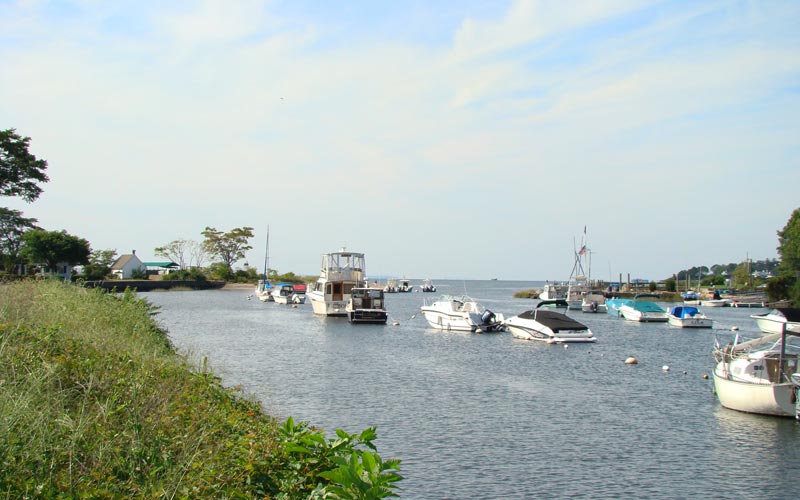
As recently as 2005, a five foot hedge lined the back of the fourth tee. With the hedge now gone, golfers are free to take in this view of Southport Harbor as it empties into the Long Island Sound.
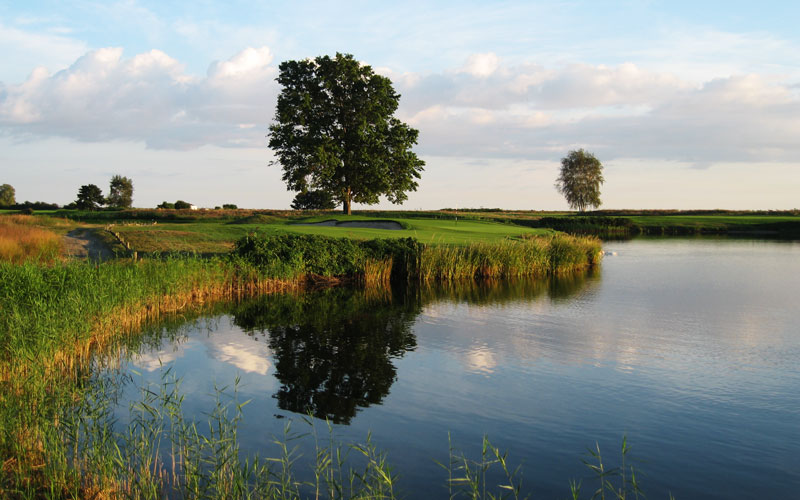
Tillinghast’s green location with the pond flush against the front and right side of the green makes this one of the scarier Short holes. Especially on a windy day, a ‘5’ is a distinct possibility. Nonetheless, the good golfer appreciates the opportunity to demonstrate his ability to control the flight of his ball in such conditions.
Fifth hole, 360 yards; Lagoon; Initially, Raynor routed the course under the assumption that the clubhouse would be located along the sound (near today’s seventh tee on the southwest portion of the property). Shortly after the initial routing was completed, the decision was made to use a house on Sasco Hill as the clubhouse instead of building at the beach. The sequence of Raynor’s holes was thus altered but the result was not ideal from either a visual or physical orientation to the clubhouse. As late as 1939, Tillinghast also labored under the assumption that the final permanent clubhouse would be beachside. However, after three hurricanes hit the Connecticut shoreline in 1954, the club decided once and for all that a clubhouse location on Sasco Hill would be best. Robert Trent Jones was brought into help reconfigure the holes to allow for the higher, inland clubhouse location. In so doing, Trent Jones created three new holes (the eleventh, seventeenth, and eighteenth) and either reconfigured, rerouted or changed the par at several others including the first, second, fifth, tenth, and twelfth. Here at the fifth,Trent Jones altered Raynor’s straightaway Alps hole to become a dogleg right over the lagoon. As any Raynor course is about playing angles, this hole fits in nicely from a strategic perspective.
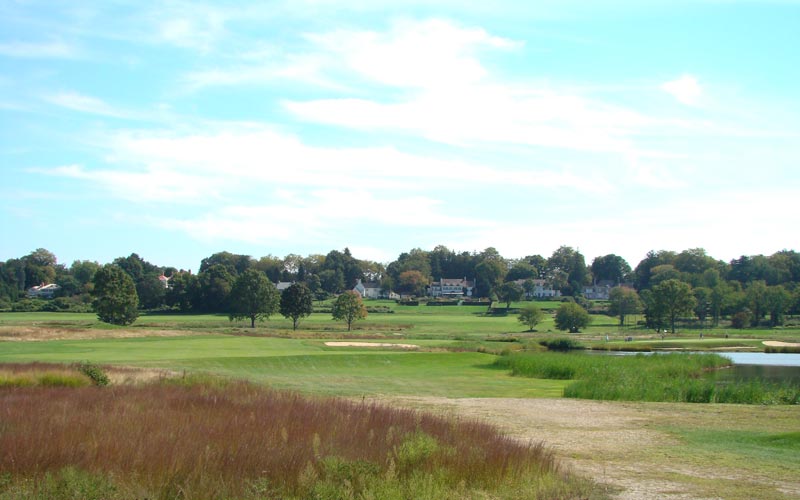
The green is well to the right over the pond. The golfer’s focus on the tee is whether to carry the bunker on the inside of the dogleg or to play left.
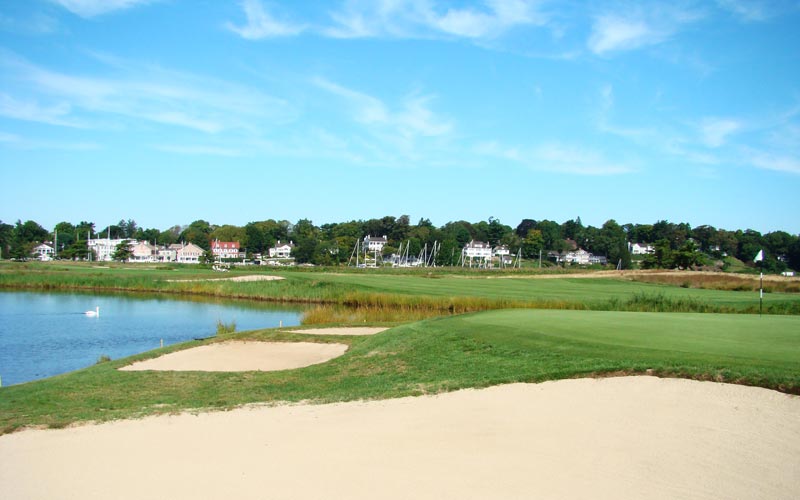
As seen from its back right, the built-up green pad at the fifth fits in nicely on a Raynor course. Thanks to the work done in recent times, the RTJ bunkers now tie nicely in with Raynor’s.
Sixth hole, 430 yards, Cape; Raynor put the New England topography to spectacular use at both Yale Golf Club (thirty minutes by car from Fairfield) and Fishers Island (three hours by boat from Fairfield) to the point where both those courses are generally considered his two finest designs. A similar opportunity to create a series of unique holes by incorporating natural land forms didn’t exist at Fairfield given its modest topography. Nonetheless, as we see, Raynor created numerous flat holes of great interest, either through neat bunkering schemes or great green complexes or both. Ultimately though, there is only but so much that the architect can do in such a situation. However, the club’s founders were fortunate that the 150 acre parcel of land that they bought included a nine acre tidal lagoon. Simply for variety’s sake, the course is better for it. Of the three holes that play across it today, Tillinghast deserves credit for bringing it more into play here at the sixth as well as the fourth and Robert Trent Jones did so at the fifth. In the mid-1910s when Raynor begin work here, water enjoyed little favor as a primary hazard in part because golf balls were expensive and the notion of finishing a round with the same ball held sway. In 1939, similar to what he suggested at the Short, Tillinghast had the sixth green pushed well to the right and near the lagoon. Fortunately, Tillinghast was one of the all-time great builders of green complexes and the one here is one of his best. Similar to the Cape Hole at Mid-Ocean where Raynor assisted Macdonald on construction, Tillinghast’s bold Cape green complex at Fairfield is every bit as impressive as its heroic Cape tee shot.
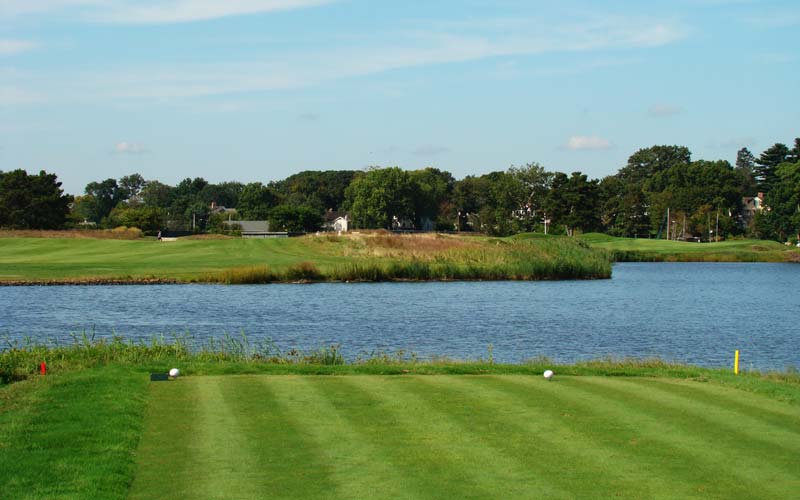
The classic Cape conundrum: with the white flag waving in the breeze to the right in the distance, the golfer dearly loves to hug the right of the fairway (where there is a speed slot that propels tee balls forward) for the sake of having a shorter approach shot. Tee balls played cautiously to the left and away from the water often leave a 200 yard plus approach shot. Tillinghast called this a ‘magnificant’ (sic) hole.

Note the convoluted green with its high left bank available to help kick ball right and onto the green. As seen above, the fairway line is too far removed from the water hazard and the club is wisely considering shifting the fairway to the right.
Seventh hole, 310 yards, Dunes; Several of the best short par fours that either Raynor of Macdonald built were of the Knoll variety (i.e. a fortressed green well elevated from its surrounds). Fine examples are found at Yale and Piping Rock. The exact opposite sort of a short two shotter is found here with the seventh green glued to the ground and on a front to back tilt that runs away from the golfer. Today’s technology makes this hole a real teaser as golfers can drive the ball within twenty to forty yards of the putting surface with favorable wind conditions. However, just as Tiger Woods found when he otherwise annihilated the field at the 2000 Open on the Old Course at St. Andrews, it is such fiddly length shots to greens that run away that prove the most perplexing. Many long time members still puzzle over how best to play this ‘touch of poetry.’ Given its vexing nature, consideration would have to be given to it for inclusion on any eclectic list of Raynor’s eighteen best holes. Hepner considers it his favorite on the course because, as he says, it ‘remains timeless no matter how far you hit the ball. It is all about the approach angle and the delicate touch of that shot. I could sit in the approach area and hit a multitude of shots for hours.’
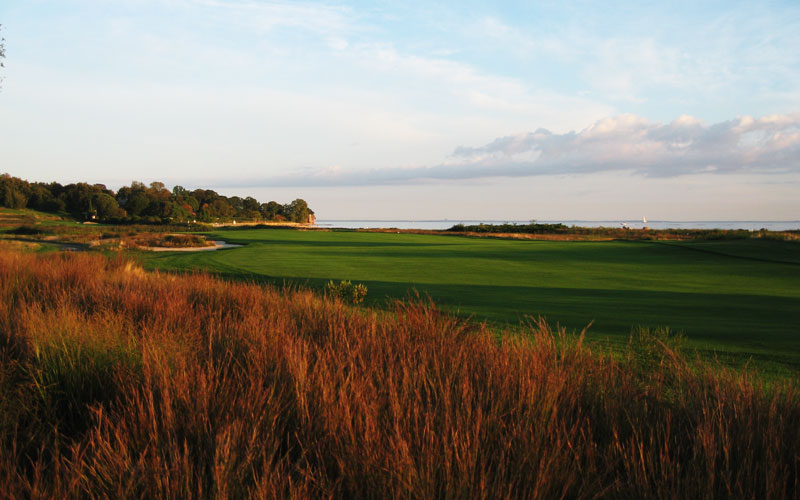
Nothing dramatic but the seventh is full of great character. The fairway crests five feet above the tee 240 yards out. From there, the long green runs away from the golfer.
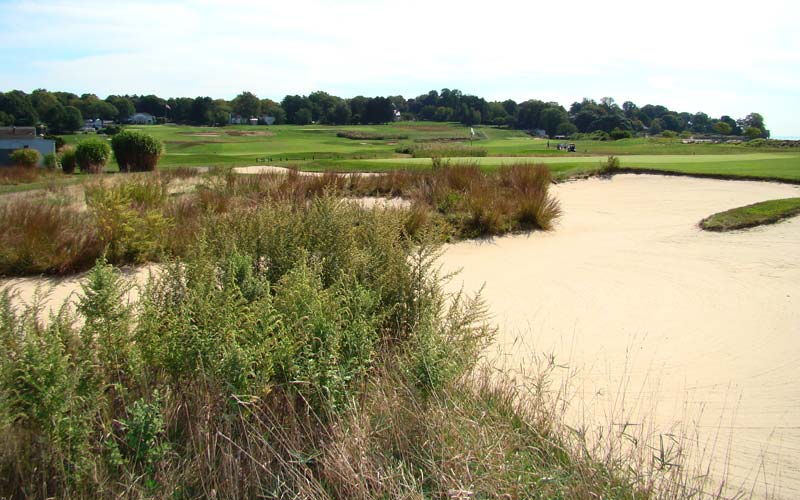
Bruce Hepner is a master at restoring features to courses while looking like he was never there. Such is the case with this wonderful long hazard down the left of the seventh fairway.
Eighth hole, 520 yards, Sound; When working on a Golden Age course, the most likely type hole in need of help is going to be the par fives. After all, many such holes were designed in the 470 to 495 yard range and with today’s technology, these holes lose their playing integrity. Such was the case here but in an unusual twist, a ready solution presented itself to Hepner. By creating a new back tee high on the dune wall that overlooks the sound, it now became very difficult to carry the sea brush along the water off the tee. With no short cut available off the tee, the hole was returned to where it now frequently plays as a true three shotter.
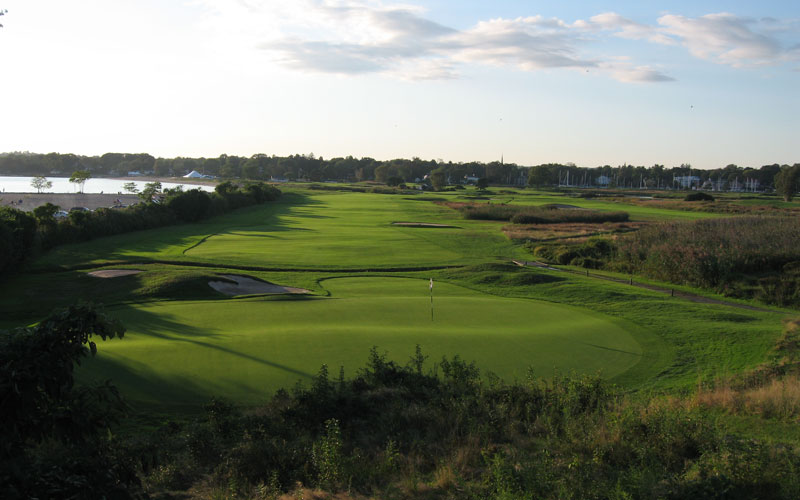
Looking back down the long eighth, the challenge is to play down the sound side of the fairway (while avoiding the bunker 100 yards short of the green that is just visible above) and to place one’s approach on the same tier as the day’s hole location. George Bahto, the leading authority on Raynor, considers this one of Raynor’s finest greens.
Ninth hole, 200 yards, Redan; At least six of Seth Raynor’s designs routinely vie for inclusion among the world top one hundred golf courses, making some modern architects sniff that his work garners too much attention/praise. After all, they argue, the man repeated numerous design themes throughout his designs. To them, this is a sign of weakness as perhaps Raynor was running low on original ideas and concepts of his own. Such comments probably are born out of jealousy, primarily at the fact this engineer was afforded the opportunity to work on so many excellent sites. Fairfield is, of course, one such site and indeed, the author looks at Raynor’s appreciation of the Redan as a blessing. Take here at the ninth for instance. Without a preconceived desire for such a right to left falling hole, what architect would have seen that this abrupt hillside presented the perfect opportunity into which to bench a Redan green? Probably not many and one of the world’s three or four great Redans would never have been built. Hepner pronounces the ninth to be ‘as strong a Redan as you will ever find as it features a great angle and no background, plus the most uniquely contoured approach area that I’ve seen.’
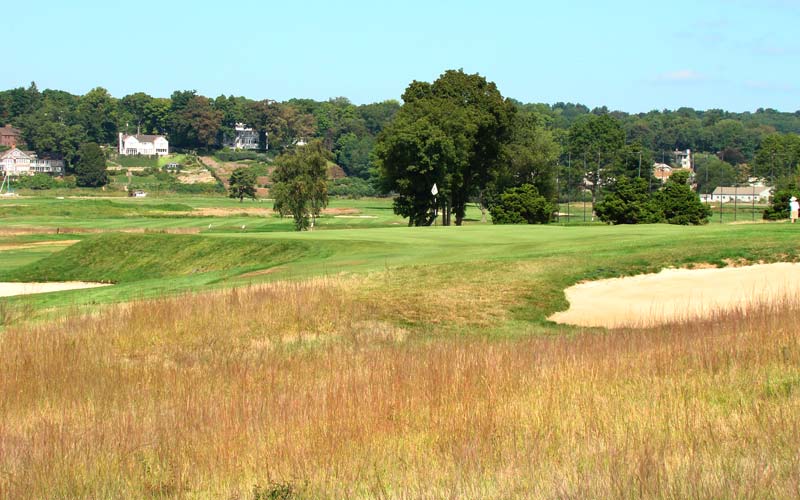
A picture perfect Redan: the short bunker, the right to left tilt, and the deep left greenside bunker.
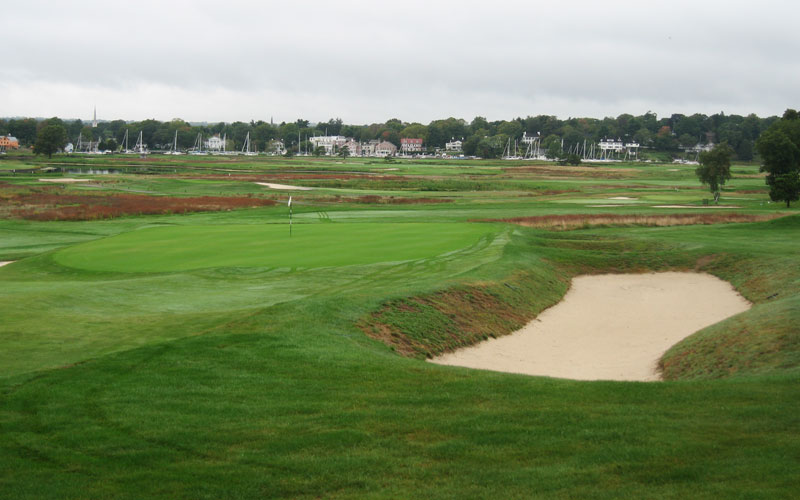
Note the area before the putting surface in this early morning photograph from high right. In particular, the spine of a ridge and the indentation in the ground to its right lead to many interesting – and unpredictable – bounces onto the putting surface.
Twelfth hole, 425 yards; Dogleg; As part of Trent Jones’s work, this hole was shortened some sixty yards and converted into a par four. As opposed to what would be an easy par five today, this hole is now the longest par four on the back nine. While difficult, the hole is full of appeal. Esthetically, it enjoys a rustic flair thanks to the wide variety of grasses and native vegetation promoted by Green Keeper David Koziol. Also, Raynor only moved dirt where it mattered which here was in creating a most attractive greensite. Importantly, the green is open in front, making it well suited to accept shots from well back in the fairway on this converted par four.
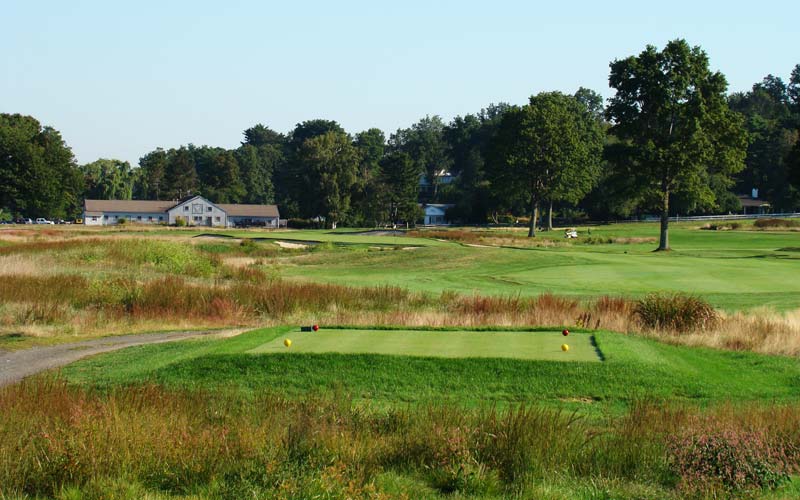
Though the twelfth heads away from the sound, it remains visually arresting thanks to its rich texture. Mercifully, Fairfield is far removed from a typical American course where only shades of green tend to greet the eye. Note how the fairway swings out to the right, which helps the hole visually as well as from a golf perspective.
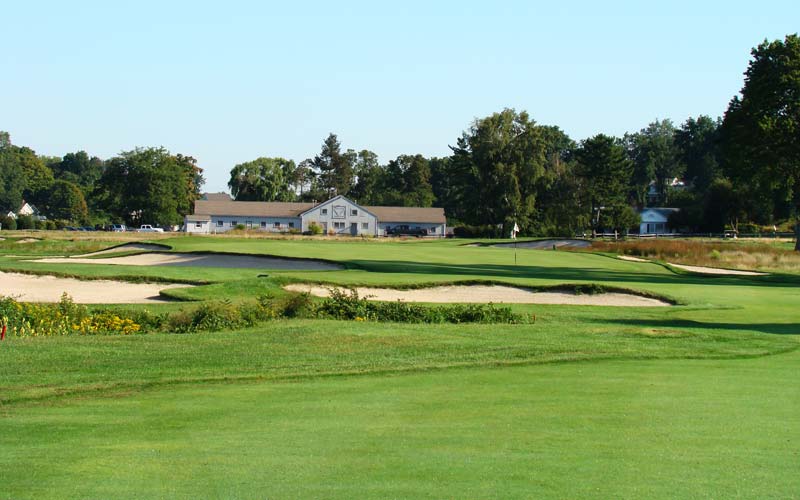
Though the green looks and plays like an extension of the fairway, Raynor needed to build up the green pad by four feet in the back to make it the appealing target that it is today. Importantly, the bunkers in the foreground are forty yards from the front of the green, giving the golfer plenty of room to run a ball onto the putting surface. If the bunkers were flush against the green, it wouldn’t function properly as a target for a long par four.
Fourteenth, 180 yards, Eden; How Raynor adopted his favorite classic holes to any given site is always of great interest to any Raynor student. Frequently, stories emerge and such is the case here at the Eden. Several of the usual suspects are found including the Strath bunker on the right and a sharply tilted back to front putting surface. No surprise though that when Raynor historian George Bahto was walking the property, he immediately queried what had happened to the Hill bunker on the left. This is certainly a reasonable observation as every Raynor Eden featured these two prerequisite bunkers. Work commenced by the club to explore where this bunker had been but before they got more than two feet below ground, they struck water! Indeed, the water level was such that the Hill bunker had never been built.

Only one bunker guards this Eden. To the club’s credit, the reeds that once framed this green behind have been cut down, giving the golfer fits with depth perception. Macdonald would have approved of this Eden as he hated the fact that the original version could be played tee to green with a putter – not so here!
Fifteenth hole, 420 yards, Plateau; Given all the good work that has been accomplished at Fairfield since implementing a Master Plan with Renaissance Golf and Bruce Hepner in 1999, the single most exciting prospect left is re-capturing the front left plateau of this Double Plateau green. Work is scheduled to commence in the winter of 2009 and when completed, this nearly 9,000 square foot (!) green will be a sight to behold. Double Plateau holes are always among the most fun to play on a Raynor/Macdonald course and this will be no exception. As it stands now, it is a fine, solid hole but lacks the inspiration that Raynor enthused into it.
Sixteenth hole, 400 yards, Burn; Though a burn tracks down the right of the fairway, it is the green itself that provides the hole so much of its character. Indeed, the easiest way to lend flat property playing interest is always at the green site, though one may not know that based on all the insipid tee to green mounds found on so many modern courses. The random interior contours found on this large 7,901 square foot green are rarely more than twelve inches in height and allow the green complex to stay in keeping with its surrounds while at the same time providing good golf.
Seventeenth hole, 190 yards, Cockenoe; Any architect would prefer to start with a clean slate rather than to inherit a routing with which he had to work. However, Robert Trent Jones’s mission statement was curtailed to making the holes flow better once the decision was finalized to keep the clubhouse location on Sasco Hill. His plan was carried out in two phases, one in 1961 and the other in 1970. As part of phase two, two entirely new holes were built so that the course finished up the hill at the base of the new clubhouse. Indeed, if Raynor had worked from this clubhouse location, perhaps this would have been his Eden hole as the backdrop reminds manyof the Eden’s at St. Andrews.

The built-up tee pads at the seventeenth afford the perfect perspective across the pond and out to the sound. The challenge varies wildly here at the penultimate hole: into the wind and the golfer is happy to reach the putting surface. Downwind, the golfer struggles to make sure his tee ball stays below the hole on this steeply pitched green.
Eighteenth, 385 yards, Home; By the end of his career, the name Robert Trent Jones was synonymous with a long difficult par four finishing hole. Ending one’s round at Fairfield on such a dullish note would be disappointing given the fun and inspiring nature of the golf that has gone before. Fortunately, Jones’s creation here is the best of both worlds: tough but requiring finesse. The rub is the green, which falls four feet from back to front, ruthlessly exposing frayed nerves.
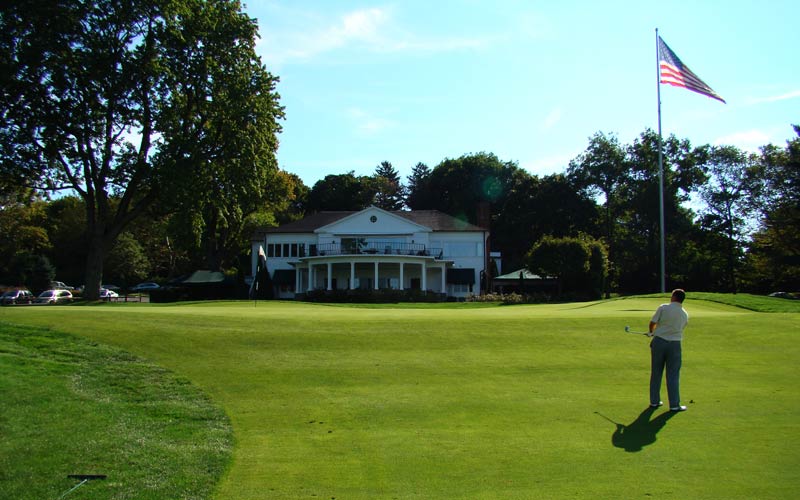
This golfer’s approach landed seven feet onto the putting surface before spinning back to here from where he had a nervy little pitch. Conversely, the golf ball twenty feet past the hole left that golfer with a very swift downhill putt from where he gladly accepted two putts.
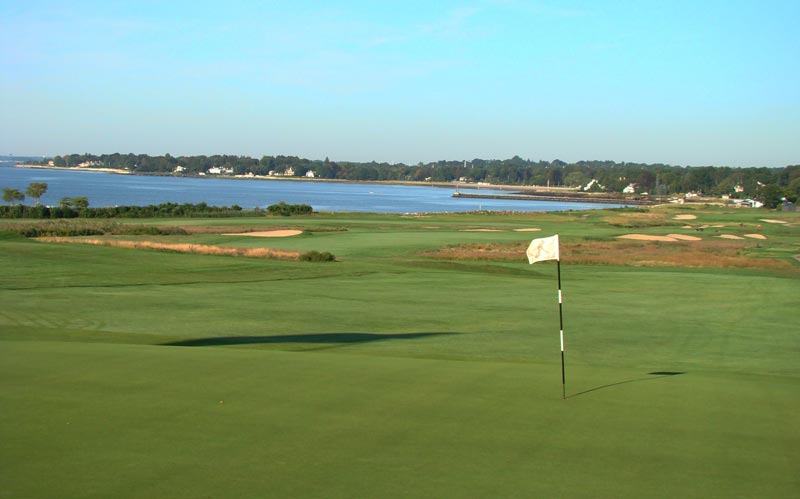
Having just carried his bag and finished eighteen holes in under three hours with his playing partner, the golfer looks back down the eighteenth and across the course and wonders if there is any better environment for a game in the northeast.
If Fairfield sounds like an idyllic spot for a game, that’s because it is. However, it is so because of the intelligent work that has been carried out here in the past decade. Prior to that, several hundred trees dotted the landscape and undermined its trump card of long views in a coastal setting. In addition, no concerted effort had been made to seamlessly tie in the Trent Jones holes with those of Raynor. Working together in a slow and methodical manner, the club and Hepner have successfully addressed these two primary issues. As Hepner puts it, ‘Fairfield has been an interesting project that we are trying to re-Raynorize a mix-match design as there have been several fingers in the pie over the years. I think we have the landscape back to the original sea side design and that was the first and most important step. Now it is just grinding hole by hole to re-create classic interest into the design. I’d say we are half done with the Raynor design features, but the landscape (trees or lack thereof) is especially pretty darn good.’
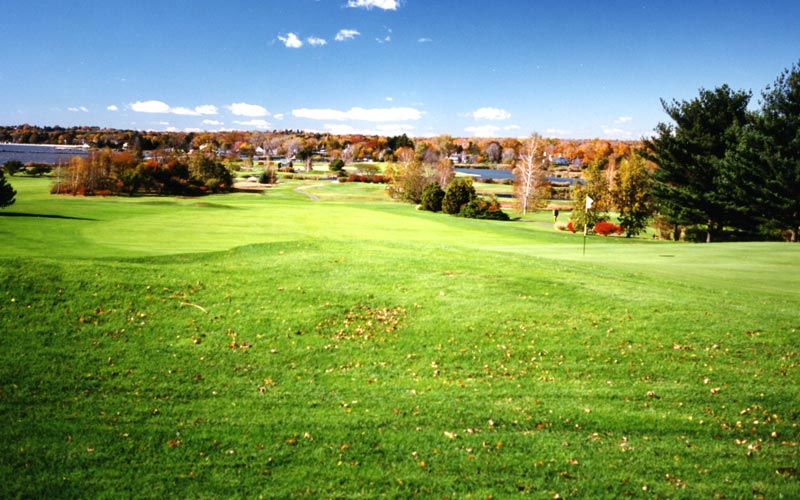
As seen above in a photograph from 2002, trees once hindered the view and thus diminished the impact of Fairfield’s ultimate trump card of its coastal setting.
As Fairfield stands now, the temptation after a round is to sit out on the porch twenty yards behind the eighteenth green with a rum float and enjoy the sweeping views across the course and out to Long Island Sound. However, the greater temptation may well be to head back out for either a few more holes or perhaps another round altogether. This is the greatest compliment that any course can receive. Unlike so many parkland courses in the northeast that wear down the golfer, the player here feels invigorated and is keen to get back out to enjoy the golf challenges as well as all that nature has to offer. Indeed, the golf is so fun that the player may be forgiven for thinking that he is in the United Kingdom, so strong is the spirit of the game here.
The End

